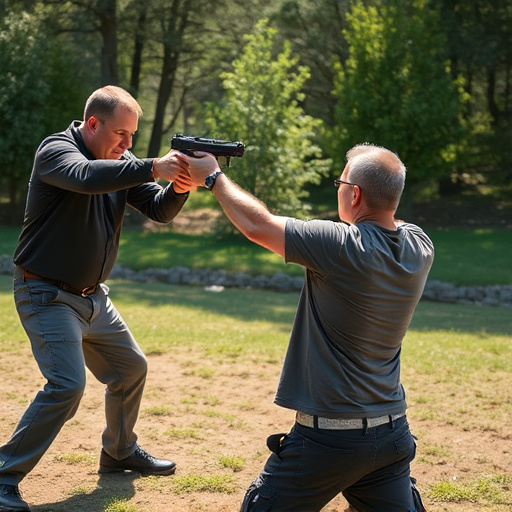The ideal storage temperature for pepper spray is 50°F to 70°F (10°C to 21°C) to maintain potency and longevity. Store it away from direct sunlight, heat sources, and extreme conditions that can degrade the active ingredient, capsaicin. Regular testing and adherence to local legalities regarding possession and use are crucial for reliable self-defense.
“Discover the power of self-defense with an inflammatory spray device, a valuable tool for personal safety. This comprehensive guide explores the inner workings of pepper spray composition and sensitivity, offering insights into optimal storage conditions to maintain longevity and effectiveness. Learn about choosing secure containers and navigating legal permits and restrictions.
Additionally, we provide essential maintenance tips and guidelines for replacement, ensuring your spray remains reliable. Uncover the ideal best storage temperature for pepper spray to maximize its potential as a game-changer in personal defense.”
- Understanding Pepper Spray Composition and Sensitivity
- Optimal Storage Conditions for Longevity and Effectiveness
- Choosing the Right Container for Safe Keeping
- Legal Considerations: Permits and Restrictions
- Regular Maintenance and Replacement Guidelines
Understanding Pepper Spray Composition and Sensitivity
Understanding the composition of pepper spray is crucial in knowing its effectiveness and sensitivity. Typically, a self-defense inflammatory spray device contains capsaicin, a chemical derived from chili peppers, which irritates the eyes, nose, and respiratory system when inhaled. The potency of pepper spray varies based on the concentration of capsaicin; higher concentrations offer more protection but also require proper handling to avoid accidental activation or exposure.
When considering the best storage temperature for pepper spray, it’s essential to keep it in a cool, dry place, away from direct sunlight and heat sources. The recommended range is usually between 50°F to 70°F (10°C to 21°C). Storing it at the right temperature ensures its potency remains optimal and prolongs its shelf life, keeping you safe when you need it most.
Optimal Storage Conditions for Longevity and Effectiveness
To ensure optimal longevity and effectiveness, self-defense inflammatory spray devices should be stored at a best storage temperature between 50°F to 70°F (10°C to 21°C). Extreme temperatures, both hot and cold, can degrade the active ingredients in the pepper spray over time. For instance, prolonged exposure to heat may cause the chemical components to evaporate or become less potent, while cold temperatures might result in solidification of the spray, affecting its dispersal mechanism.
It’s crucial to keep these devices away from direct sunlight and maintain consistent humidity levels. High humidity can lead to moisture buildup inside the container, potentially causing corrosion or damage to the spray mechanism. Conversely, low humidity environments may cause the spray to dry out prematurely. Storing self-defense sprays in a cool, dark, and dry place, such as a locked drawer or cabinet, is ideal to maximize their useful life and retain their effectiveness when you need them most.
Choosing the Right Container for Safe Keeping
When it comes to storing your self-defense inflammatory spray device, or pepper spray, choosing the right container is paramount. Opt for a sturdy, airtight container designed specifically for pepper spray storage. This not only protects the contents from physical damage but also ensures the spray remains potent and effective.
The best storage temperature for pepper spray is typically between 50°F to 70°F (10°C to 21°C). Extreme temperatures can degrade the active ingredients, reducing the spray’s effectiveness. Avoid storing it in direct sunlight or freezing conditions, as these can also accelerate spoilage. Keeping your pepper spray in a controlled environment, away from heat sources and direct light, will ensure its longevity and reliability when you need it most.
Legal Considerations: Permits and Restrictions
When considering a self-defense inflammatory spray device, such as pepper spray, understanding legal considerations is paramount. The use and possession of such devices are subject to stringent regulations that vary widely depending on your location. In many jurisdictions, obtaining a permit for carrying pepper spray is mandatory, with specific requirements regarding the type of spray allowed and its concentration. For instance, some regions mandate storage in a secure location, like a locked drawer or safe, with clear labeling indicating its contents and hazard level.
The best storage temperature for pepper spray is typically between 50°F and 70°F (10°C to 21°C), away from direct sunlight, heat sources, and incompatible substances. Adhering to these guidelines not only ensures the effectiveness of the spray but also helps in avoiding legal repercussions. It’s crucial to research local laws and gain a thorough understanding of the permitted uses, quantities, and storage protocols for maintaining compliance.
Regular Maintenance and Replacement Guidelines
To ensure optimal performance, regular maintenance and timely replacement are crucial aspects of self-defense inflammatory spray device ownership. Store your pepper spray at the best storage temperature—typically between 50°F to 70°F (10°C to 21°C)—to prevent degradation of the active ingredients. Avoid extreme temperatures and direct sunlight, as these conditions can accelerate spoilage.
Follow manufacturer recommendations for replacement intervals. Most pepper spray devices should be replaced after 3 to 5 years or when the spray pattern becomes inconsistent, indicating reduced effectiveness. Regularly test your device by firing a test shot to ensure it deploys correctly and fully. Proper maintenance and timely replacements are key to having a reliable self-defense tool when you need it most.
In conclusion, mastering self-defense with an inflammatory spray device requires knowledge of its composition, proper storage, legal awareness, and regular maintenance. By understanding optimal storage conditions, including the best storage temperature for pepper spray, choosing suitable containers, and adhering to legal guidelines, users can ensure their devices remain effective and safe. Regular upkeep and timely replacement are crucial to maintaining optimal performance. Armed with this information, individuals can make informed decisions to protect themselves effectively in various situations.
